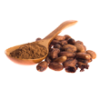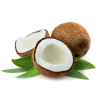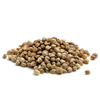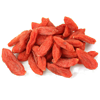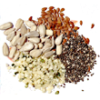These "Superfoods" are some of the healthiest most nutrient dense foods on the planet. Packed with protein, EFA's, vitamins, minerals, and antioxidants, you know every bite you take is doing your body good! Let’s take a closer look at the nutrients present in some of the superfoods we have to offer:
VITAMINS & MINERALS
It’s safe to say that most of us know that healthy foods are chock full of vitamins and minerals, but the nutrient content of some super foods may surprise you.
-
Cacao (dark chocolate) is high in magnesium and iron.
-
Goji berries are a potent source of vitamin C - contains 500x more vitamin C than the same weight in oranges.
-
Pumpkin seeds are high in zinc and manganese
-
Blueberries are a good source of vitamin K
ANTIOXIDANTS & PHYTOCHEMICALS
Phytochemicals are chemicals in plants that give them their rich colours, smells, and tastes. Some phytochemicals can also be considered antioxidants.
Antioxidants are natural chemical molecules in foods that help neutralize free radicals in the body. Free radicals are by-products of energy production that can cause health problems in the body like heart disease, cancer, arthritis, stroke, respiratory diseases, and immune deficiency.
Here examples of some of the different phytochemicals found in our superfoods:
-
Flavonoids found in cacao nibs are potentially related to reducing oxidative damage to LDL “bad” cholesterol and increasing HDL “good” cholesterol, decreasing blood pressure, and improving blood flow to the brain and improve cognitive function.
-
Anthocyanins are a specific type of flavonoid found in berries, such as blueberries and tart cherries, that give them their rich colour. One study found that high anthocyanin intake from blueberries and strawberries decreased the risk of heart attacks in young to middle-aged women.
-
Carotenoids (specifically beta-carotene) found in golden berries and especially goji berries are phytochemicals that contribute to their vibrant orange and red colours, respectively. Beta-carotene is vital for eye, skin, and bone health, as well as cell development.
-
Polysaccharides are chemical compounds found in goji berries that improve the immune system and increase antioxidant activity in the body.
-
Plant lignans are found in high concentrations in flax seeds and to a lesser extent in sesame seeds. Lignans are powerful antioxidants and have estrogenic properties and can both increase or decrease estrogenic effects in the body. Some observational and small-scale studies show that consuming flax seeds can decrease the risk of breast and prostate cancer.
-
Phytosterols are compounds found in plants that are similar to cholesterol. The highest concentrations are found in unrefined vegetable oils, beans, and nuts. One of their health benefits is that phytosterols can lower total cholesterol and LDL “bad” cholesterol. There is evidence that phytosterols may help prevent lung, stomach, breast and ovarian cancer. Phytosterols also increase antioxidant activity. Some super foods that have phytosterols include sesame seeds, pumpkin seeds, and goji berries.
HEALTHY FATS
There are a few types of healthy fats that can be found in our superfoods.
One type of healthy fats are polyunsaturated fats, the most researched being omega-6 and omega-3 essential fatty acids. The body cannot make essential fatty acids, so you have to get them from your food. Plant sources like chia, flax, and hemp seeds have different amounts of these essential fatty acids. In the typical western diet, we consume way too much omega-6s in relation to omega-3s, and this can contribute to chronic inflammation in the body and a host of related health conditions. Ideally, if we can consume more omega-3s in our diet, this can have a more anti-inflammatory effect on the body.
Some potential health benefits related to increased consumption of omega-3 fatty acids:
-
Reduce age-related mental decline.
-
Improve infant development (when taken by mothers prenatally and when breastfeeding).
-
Promotes heart health.
Another healthy fat is a class of saturated fats called medium chain triglycerides. This can be found in coconut products. Some potential health benefits include the following:
-
Increases calorie burning compared to the consumption of other types of fats.
-
Reduces appetite.
-
Promotes heart health by increasing HDL (“good”) cholesterol.
-
Reduces harmful visceral belly fat.
-
Helps prevent infections.
FIBER
Fiber is the non-digestible compound found in plant food. They’re usually categorized as soluble (dissolves in water) and insoluble (does not dissolve in water). Many of our super fruits and seeds are good sources of fiber. There are many benefits to including more fiber in your diet:
-
Some fibers are considered food (or prebiotics) for your good gut bacteria. This enables the gut bacteria to produce nutrients like short-chain fatty acids that feed your colon cells. The effect is a decrease in gut inflammation.
-
Promotes satiety and some forms of fiber can aid in weight loss.
-
Foods with soluble fiber are lower on the glycemic index and reduce post-meal blood sugar spikes.
-
May reduce total cholesterol and LDL “bad” cholesterol which promotes heart health.
-
Can decrease constipation.
-
May decrease risk of colon cancer.
Adding superfoods to your diet is a great idea, but it’s best if they’re added to an already healthy diet. Let’s face it, including a handful of blueberries to your breakfast isn’t going to undo the daily donut and caramel iced frappuccino. And when it comes to eating whole foods, including superfoods, it’s always good to remember to “eat a rainbow”. Different colours of foods likely have different health-promoting phytochemicals. So if you eat a variety of different colours, you’re ensuring that you are getting the full spectrum of nutrients and antioxidants that superfoods have to offer.
